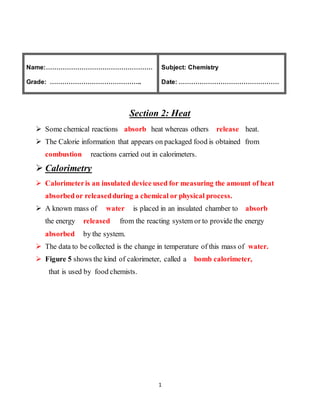
Heat
- 1. 1 Name:…………………………………………… Grade: …………………………………….. Subject: Chemistry Date: ………………………………………… Section 2: Heat Some chemical reactions absorb heat whereas others release heat. The Calorie information that appears on packaged food is obtained from combustion reactions carried out in calorimeters. Calorimetry Calorimeteris an insulated device used for measuring the amount of heat absorbedor releasedduring a chemical or physical process. A known mass of water is placed in an insulated chamber to absorb the energy released from the reacting system or to provide the energy absorbed by the system. The data to be collected is the change in temperature of this mass of water. Figure 5 shows the kind of calorimeter, called a bomb calorimeter, that is used by food chemists.
- 2. 2
- 3. 3 Determining specificheat Satisfactory results can be obtained in your calorimetry experiments using the much simpler foam-cup calorimeter. Assuming no heat is lost to the surroundings, the heat gained by the water is equal to the heat lost by the metal. This quantity of heat can be calculated q = c × m × ΔT First, calculate the heat gained by the water Specific heat of water, 4.184 J/(g·°C). q water = 4.184 J/(g·°C) × 125 g × (29.30°C - 25.60°C) q water = 4.184 J/(g·°C) × 125 g × 3.70°C q water = 1940 J
- 4. 4 The heat gained by the water, 1940 J, equals the heat lost by the metal, q metal , so you can write this equation. q metal = q water q metal = −1940 J c metal × m × ΔT = -1940 J EXAMPLE Problem 3
- 6. 6 Chemical Energyand the Universe Every chemical reaction and change of physical state either releases or absorbs heat. Thermochemistry Is the study of heat changes that accompanychemicalreactions and phase changes. In thermochemistry, the system is : The specific part of the universe that contains the reactionor process you wish to study. Everything in the universe other than the system is considered the surroundings. Therefore, the universeis defined as: The system plus the surroundings. Universe = system + surroundings During exothermicreactions Heat produced bythe reaction flows from the system to the surroundings. In an endothermic reaction or process , The flow of heat is reversed. Heat flows from the surroundings to the system Enthalpyand enthalpychanges it is impossible to know the total energy content of a substance. Chemists are usually more interested in changes in energy during reactions than in the absolute amounts of energy contained in the reactants and products. For many reactions, the amount of energy lost or gained can be measured conveniently in a calorimeter at constant pressure
- 7. 7 Enthalpy(H) Is the heat content of a system at constant pressure. Although you cannot measure the actual energy or enthalpy of a substance, you can measure the change in enthalpy, which is the heat absorbed or releasedin a chemical reaction. Enthalpy(heat) of reaction (Δ H rxn ). The change in enthalpy for a reactionis calledthe enthalpy (heat) of reaction (Δ H rxn ) Δ H rxn = H final - H initial Δ H rxn = H products - H reactants The sign of the enthalpyof reaction Exothermic reaction lose heat. Therefore, H products < H reactants . Enthalpy changes for exothermic reactions are always negative. Example heat-pack: 4Fe(s)+ 3 O 2 (g) → 2F e 2 O 3 (s) Δ H rxn = -1625 kJ
- 8. 8 For this endothermic process, H products > H reactants Therefore, A positive value for Δ H rxn is obtained. Example cold -pack : N H 4 NO 3 (s) → N H 4 + (aq) + N O 3 - (aq) Δ H rxn = 27 k The enthalpy change, ΔH, is equal to q p , the heatgained or lost in a reaction or process carriedout at constant pressure. q = Δ H rxn .
